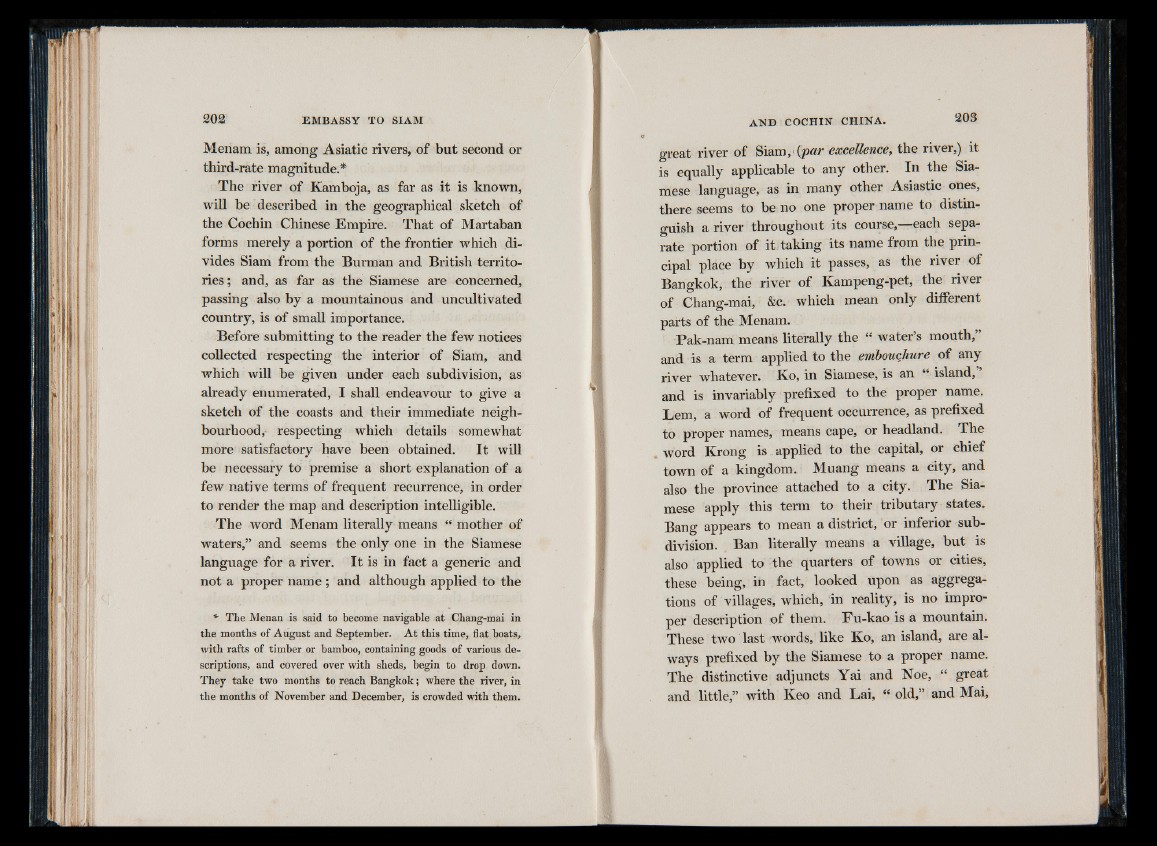
Menam is, among Asiatic rivers, of but second or
third-rate magnitude.*
The river of Kamboja, as far as it is known,
will be described in the geographical sketch of
the Cochin Chinese Empire. That of Martaban
forms merely a portion of the frontier which divides
Siam from the Burman and British territories
; and, as far as the Siamese are concerned,
passing also by a mountainous and uncultivated
country, is of small importance.
Before submitting to the reader the few notices
collected respecting the interior of Siam, and
which will be given under each subdivision, as
already enumerated, I shall endeavour to give a
sketch of the coasts and their immediate neighbourhood,
respecting which details somewhat
more satisfactory have been obtained. I t will
be necessary to premise a short explanation of a
few native terms of frequent recurrence, in order
to render the map and description intelligible.
The word Menam literally means “ mother of
waters,” and seems the only one in the Siamese
language for a river. I t is in fact a generic and
not a proper name ; and although applied to the
* The Menan is said to become navigable at Chang-mai in
the months of August and September. At this time, flat boats,
with rafts of timber or bamboo, containing goods of various descriptions,
and covered over with sheds, begin to drop down.
They take two months to reach Bangkok; where the river, in
the months of November and December, is crowded with them.
great river of Siam, (p«r excellence, the river,) it
is equally applicable to any other. In the Siamese
language, as in many other Asiastic ones,
there seems to be no one proper name to distinguish
a river throughout its course,—each separate
portion of it taking its name from the principal
place by which it passes, as the river of
Bangkok, the river of Kampeng-pet, the river
of Chang-mai, &c. which mean only different
parts of the Menam.
Pak-nam means literally the “ water’s mouth,
and is a term applied to the embouchure of any
river whatever. Ko, in Siamese, is an “ island,
and is invariably prefixed to the proper name.
Lem, a word of frequent occurrence, as prefixed
to proper names, means cape, or headland. The
„ word Krong is applied to the capital, or chief
town of a kingdom. Muang means a city, and
also the province attached to a city. The Siamese
apply this term to their tributary states.
Bang appears to mean a district, or inferior subdivision.
Ban literally means a village, b u t is
also applied to the quarters of towns or cities,
these being, in fact, looked upon as aggregations
of villages, which, in reality, is no improper
description of them. Fu-kao is a mountain.
These two last words, like Ko, an island, are always
prefixed by the Siamese to a proper name.
The distinctive adjuncts Yai and Noe, “ great
and little,” with Keo and Lai, “ old,” and Mai,